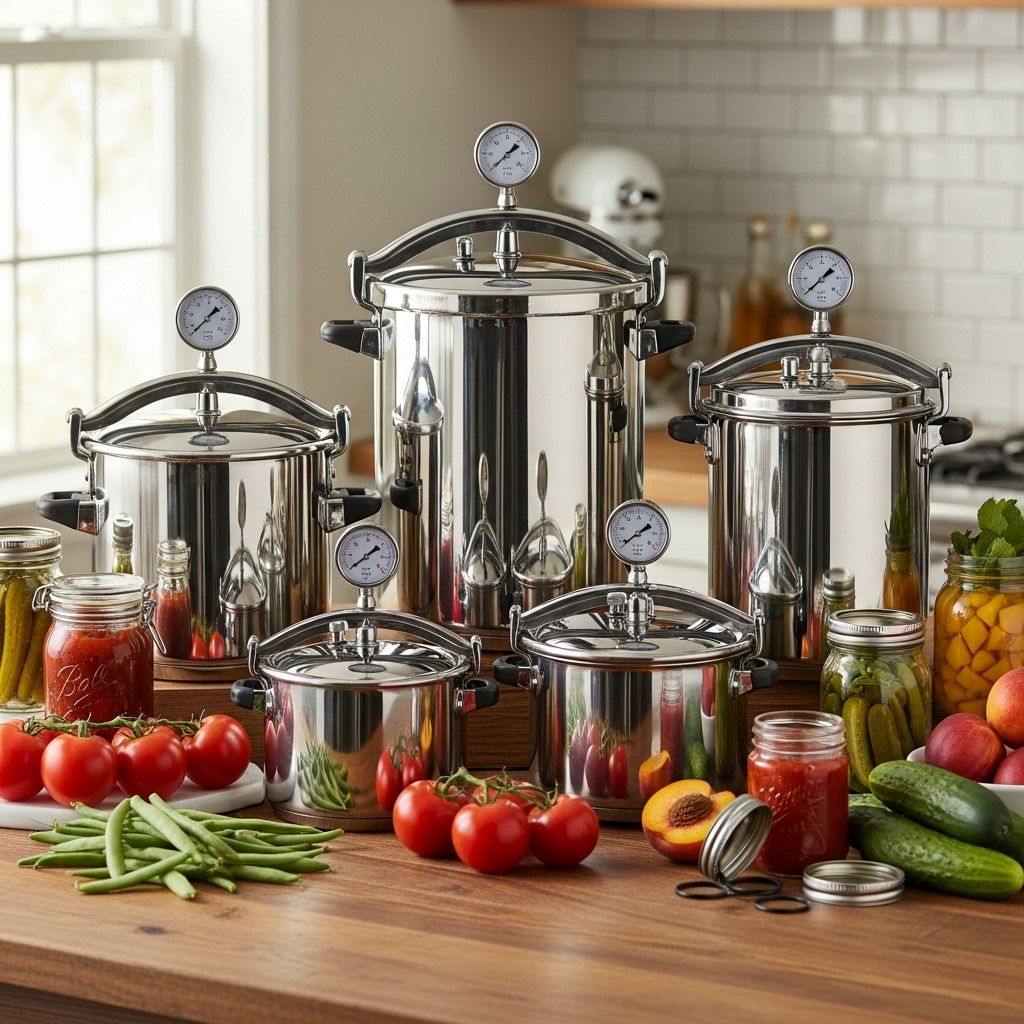The Best Pressure Canners for Home Preserving in 2025
Choose gear that delivers precise heat control, reliable sealing, and effortless batch processing.

If you’re passionate about home canning—stocking your pantry with jars of soups, vegetables, or ready-to-eat meals—the right pressure canner is essential for safety, consistency, and ease of use. This guide explores the leading pressure canners currently available, examining their features, capacity, safety mechanisms, and real-world performance. Whether you’re a novice or seasoned home preserver, you’ll find expert insights to help choose your ideal canner.
Why Pressure Canners Matter for Home Preservation
Pressure canning is the safest method for preserving low-acid foods such as meats, poultry, fish, and most vegetables. Unlike water-bath canning, which is suitable only for high-acid foods, pressure canners reach temperatures high enough to eliminate the risk of botulism and other foodborne illnesses.
- Safe for Low-Acid Foods: Essential for canning meats and most vegetables.
- Long-Term Storage: Properly canned foods can last for up to a year or more.
- Batch Cooking: Allows home cooks to preserve large quantities after harvest or bulk shopping.
How We Chose the Best Pressure Canners
To identify the top pressure canners of 2025, we analyzed manufacturer specs, user reviews, safety certifications, and expert recommendations. Key criteria included:
- Build Quality: Heavy-gauge materials for durability and consistent heating.
- Safety Features: Compliance with USDA home canning guidelines, pressure-release mechanisms, locking systems, and manufacturer warranties.
- Ease of Use: Intuitive controls, easy-to-read gauges, useful accessories.
- Capacity: Options for different batch sizes—from small kitchens to large homesteads.
- Price and Warranty: Value for money considering longevity and after-sales support.
Top Picks: The Best Pressure Canners
Below, find detailed reviews of the most popular and highly rated pressure canners currently on the market. Each model is evaluated for performance, safety, and suitability for specific canning needs.
1. All American Pressure Cooker/Canner
- Sizes Available: Multiple, including 10.5-, 15.5-, 21.5-, 25-, and 30-quart models.
- Material: Sturdy cast aluminum for even heating and robust construction.
- Heat Source Compatibility: Ideal for gas and electric stovetops.
- Safety Features:
- Metal-to-metal sealing (no rubber gasket to wear out).
- Precision-machined sealing surface.
- Easy-to-read pressure gauge and automatic over-pressure release.
- Accessories: Dual canning racks, recipe and instruction book included.
- Warranty: 1 Year Limited (with extended lifetime support).
Why It’s a Top Pick: The All American series is favored by expert canners for durability and reliability. The gasket-free design means fewer replacements, and it offers a wide range of capacities—making it practical for both small households and serious homesteaders. However, its weight and size may be overwhelming for some beginners.
2. Presto 23-Quart Pressure Canner
| Feature | Detail |
|---|---|
| Material | Heavy-gauge aluminum |
| Capacity | 7 quart jars or 20 pint jars |
| Weight | 10.5 lbs |
| Heat Source | Gas, electric, glass stovetops (household burners 12,000 BTUs or less) |
| Safety Features | Easy-to-read gauge; air vent/cover lock for safe pressure building/release |
| Warranty | 12-year limited |
| Country of Manufacture | China |
What People Say: Users praise the Presto for its combination of capacity, straightforward usage, and affordable price. With a robust safety lock and a long warranty, it’s a versatile option for beginners and cost-conscious canners alike. Customer feedback highlights ease of use and reliable sealing (“Best kitchen purchase I ever made… Very simple to understand and to use. I’ve never had anything not seal and spoil.”).
3. Presto Precise Digital Pressure Canner
- Automation: Digital controls manage time, temperature, and pressure for minimal guesswork.
- Compliance: Manufacturer asserts it meets USDA canning safety guidelines for low-acid foods.
- Innovation: Designed for those seeking a modern, push-button approach with added safety. However, independent safety testing results are still pending (experienced canners await full results).
- Versatility: Supports both pressure and water-bath canning for a variety of foods.
- Best For: Tech-savvy home canners comfortable trusting manufacturer assurances and looking for convenience.
Expert Insights: While Presto’s digital canner has promising manufacturer data and is praised for its innovation and ease of use, experts urge caution until more independent safety testing is published. Oregon State University plans to conduct such tests soon. Users must weigh digital convenience against the standards of traditional methods (“If someone wants to use this canner, they have to be willing to trust the manufacturer at this time.”).
4. Presto 16-Quart Pressure Canner
- Size: Compact enough for smaller kitchens, ideal for modest batches.
- Material: Lightweight, user-friendly design makes it great for beginners.
- Popularity: Recognized for its straightforward setup and affordable price, though higher capacities may be preferable for larger families.
5. Mirro 22-Quart Pressure Canner
- Capacity: 22 quarts; fit for mid-sized canning projects.
- Design: Generally lighter than competitors; features ergonomic handles.
- Price: Typically budget-friendly, making it accessible for beginners.
- Considerations: Fewer advanced pressure controls than some competitors.
Choosing the Right Pressure Canner for Your Needs
The best pressure canner for your kitchen will depend on your canning habits, batch sizes, and desired features. Consider the following:
- Batch Size: Those preserving produce from a large garden may prefer models above 20 quarts. Casual users may find 10–16 quarts more manageable.
- Stovetop Compatibility: Check if the canner works with your stove type—including induction and glass-topped ranges.
- Maintenance: Gasket-free designs (All American) mean fewer replacement parts but may require more careful cleaning. Traditional rubber gasket models are gentler to open but may need periodic replacement.
- Safety: Look for locking lids, pressure relief valves, and USDA compliance. Digital models are convenient but may not yet be independently certified.
Safety and Independent Testing: What Home Canners Should Know
Pressure canning safety is paramount. USDA guidelines dictate that only pressure canners reaching at least 240ºF should be used for low-acid foods. Key safety tips include:
- Buy Certified Equipment: Choose models known for safety features and manufacturer support.
- Monitor Pressure Gauges: Check accuracy before each season; replace faulty parts promptly.
- Follow Instructions: Always adhere to manufacturer and USDA canning guides for load size, pressure, and timing.
- Trust But Verify: Digital canners should comply with USDA guidelines, but monitor regulatory updates and independent lab reports before exclusive use.
Comparison Table: Pressure Canner Quick Guide
| Model | Capacity | Material | Safety Features | Price Range | Best For |
|---|---|---|---|---|---|
| All American (various sizes) | 10.5–30 quarts | Cast Aluminum | Metal Seal, Gauge, Pressure Release, Lock | $$$ | Heavy use, large batches, longevity |
| Presto 23-Quart | 23 quarts | Aluminum | Gauge, Cover Lock, Vent System | $$ | General use, budget, beginners |
| Presto Digital | 6–12 quarts | Aluminum | Digital Controls, USDA Compliant | $$$ | Convenience, tech-forward canners |
| Presto 16-Quart | 16 quarts | Aluminum | Gauge, Lock | $ | Small kitchens, modest batches |
| Mirro 22-Quart | 22 quarts | Aluminum | Basic Pressure Valve, Lock | $ | Budget-conscious, entry-level |
Frequently Asked Questions (FAQs)
Q: Can I use my pressure canner on a glass stovetop?
A: Many aluminum models, like the Presto 23-quart, are glass-stovetop compatible. However, always confirm burner strength and size, as heavy or oversized canners may crack glass ranges. Follow manufacturer recommendations.
Q: Is pressure canning safe for beginners?
A: Yes. Modern pressure canners include multiple failsafe features such as locking lids, automatic pressure release, and easy-to-read gauges. Beginners should always follow step-by-step canning recipes from reputable sources.
Q: What foods require pressure canning?
A: Low-acid items, including meats, poultry, fish, beans, and most vegetables, must be pressure canned for safe preservation. High-acid items (tomatoes with added acid, fruits, jams) may be water-bath canned.
Q: How often should I check/weigh my pressure canner’s gauge?
A: Before each canning season, ensure pressure gauges are accurate—most local extension offices or hardware stores offer testing services. Replace any damaged or non-functional parts immediately.
Q: Are digital pressure canners as safe as traditional models?
A: Manufacturers like Presto claim digital models meet USDA standards, but experts advise waiting for independent lab certification if you’re planning to can large quantities or rely exclusively on digital equipment.
Tips for Getting the Most from Your Pressure Canner
- Plan Ahead: Organize recipes, ingredient prep, and jar sterilization in advance.
- Test For Seal: After processing, always check that lids are firmly sealed before storing.
- Label and Date: Mark canned goods with production date for best rotation and use.
- Store Properly: Keep finished jars away from heat and light in a cool, dry place.
- Follow Trusted Recipes: Use only proven canning recipes to ensure food safety and quality.
The Right Pressure Canner for Every Home Kitchen
Whether you prefer traditional, heavy-duty models for batch processing or the convenience of the latest digital innovations, there’s a pressure canner to suit every home preserver. Prioritize safety, review independent recommendations, and choose the capacity and features that best fit your lifestyle. With proper techniques and reliable equipment, you can enjoy pantry shelves filled with safe, delicious, home-canned meals all year round.
References
Read full bio of Anjali Sayee












